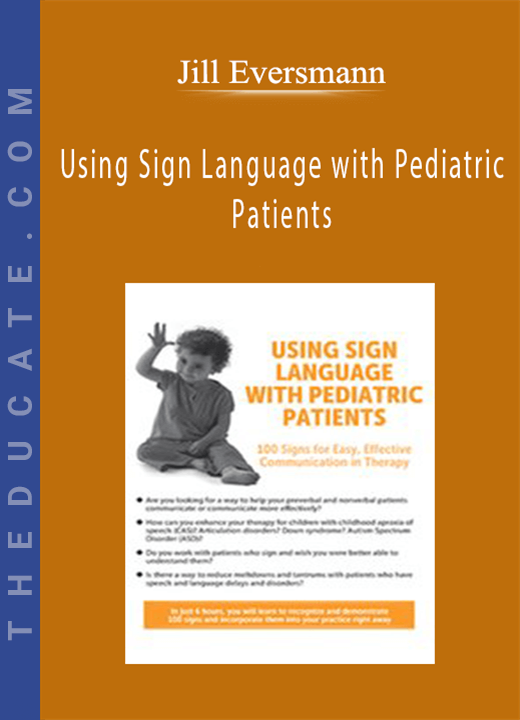Description

Using Sign Language with Pediatric Patients: 100 Signs for Easy, Effective Communication in Therapy – Jill Eversmann
In this recording, you will learn to recognize and demonstrate 100 signs and incorporate them into your practice right away.
Sign language isn’t only used by the Deaf community; it is often used by children with general speech and language delays and disorders, developmental delays, childhood apraxia of speech (CAS), autism spectrum disorder, Down syndrome, and hearing loss. One effective way to communicate with this population is through sign language. However, many don’t have time to become fluent in American Sign Language (ASL). Course instructor, Jill Eversmann, is here to help! In this recording, you will learn to recognize and demonstrate 100 basic signs, the manual alphabet, and numbers from 1-20 as well as how to incorporate them into your practice immediately.
- Recognize and demonstrate 100 basic ASL signs, the manual alphabet, and numbers 1-20
- Explain how and when to begin using sign language with a patient
- Recognize the benefits of sign language for children with Down syndrome, autism, childhood apraxia of speech, and general speech and language delays and disorders
- Distinguish the use of sign language in preverbal and nonverbal hearing patients
- Explore the benefits of using ASL as an AAC system for preverbal and nonverbal hearing patients
- Evaluate the factors to consider when determining whether or not signing is a good communication option for a patient
KEYS FOR SIGNING SUCCESS
- Brief history of ASL
- Basic rules for producing signs
- Benefits of signing
- 25 signs
- Manual alphabet
- Signing vs. spelling
- Proper names, initialized signs, describing sign formation
LAB
- ASL using songs
- Demonstration (video)
- Interactive sign review
- Interactive review of the manual alphabet
- Spelling skills
KEYS TO SIGNING IN EARLY INTERVENTION
- 25 signs
- Numbers 1-10
- How and when to start
- Indicators and contraindications
- Signing with young children
- Greetings, eye contact, and attention skills
- Supplement speech and language skills
- Reduce the frequency of tantrums
KEYS TO SUCCESS FOR THERAPISTS, HEALTHCARE PROVIDERS, & EDUCATORS
- 25 signs
- Numbers 11-20
- Signing specifics for professionals:
- SLPs
- As an AAC system
- Receptive and expressive language skills
- Improving communication when speech intelligibility is fair to poor
- Reduce auditory overstimulation
- OT/PTs
- Specific activities
- Visual representation of motor actions and descriptive terms
- Behavior programs
- Early Interventionists/Educators
- Specific signs for educators
- Early cognitive concepts
- Second language
- Visual schedules, classroom management
- Supporting behavior programs
- For children who are not strong auditory learners
- Healthcare Providers
- Specific signs for healthcare providers
- Signs for social interaction
- Communicating basic wants and needs
- SLPs
LAB
- Video
- Review of signs
- Small group practice
BENEFITS OF ASL
- Addresses a variety of learning styles
- Motor memory, decreased auditory input, multi-modality
- Improves eye contact and attention
- Benefits over other signing systems
LAB
- Interactive sign review
- 100 signs
- Manual alphabet
- Numbers







3 reviews for Using Sign Language with Pediatric Patients: 100 Signs for Easy, Effective Communication in Therapy – Jill Eversmann
There are no reviews yet.